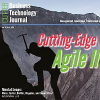Business Transformation Requires Transformational Leaders
Leadership and teaming skills are front and center in times of rapid change. Meet today’s constant disruption head on with expert guidance in leadership, business strategy, transformation, and innovation. Whether the disruption du jour is a digitally-driven upending of traditional business models, the pandemic-driven end to business as usual, or the change-driven challenge of staffing that meets your transformation plans—you’ll be prepared with cutting edge techniques and expert knowledge that enable strategic leadership.
Recently Published
The financial industry is currently focusing on AI solutions using ML and NLP technologies. Software, fintech, and regtech vendors are developing and improving models using data and supervised (training) and unsupervised learning. This proves more effective than previous AI approaches. This Advisor explores the current state of practice in the financial industry’s application of AI.
Design thinking is an elegant framing of problem-finding and -solving with a strong focus on delightful outcomes for the customer, while Agile practices focus on delivering the value envisioned in the design phase. This implies the two are equally essential to the team’s creative process. This Advisor describes the four steps in creative problem-solving that comprise the building blocks of innovation.
Many companies are unsatisfied with their innovation efforts and part of this is undoubtedly due to challenges around ideation and idea management. The required contribution of breakthrough innovation is ever-increasing, adding to this pressure. However, it is clear that some companies have developed strong processes and are reaping the rewards. The best practices outlined in this Advisor can help.
Agile is spreading and changing at such a rate that we are devoting a second issue of Cutter Business Technology Journal to the topic. As with our first issue on cutting-edge Agile, the articles come from a diverse group of authors, both male and female and from different countries.
Do We Need More Transparency?
After outlining the benefits of his company’s experiment with transparency, the author discusses the difficulties with loss of power and control, slower decision-making processes, and what he calls “frictional costs,” when ordinary workers, not specialists, are making corporate decisions. He describes his company’s approach to these difficulties.
This article describes the transition from a traditional HR world to one that fits the new culture of the Agile organization. Explore the shifts in recruiting, appraisals and reviews, salaries, and career tracks, and the difficulties facing anyone embarking on the Agile path.
This article takes agility out of its normal domain of product development into the world of research, where its use is not at all obvious. They outline the cultural blockers, note the obvious mismatches to ordinary agility, and describe how they adapted both the ceremonies of traditional agility and their own culture to form an effective final mixture.
This article describes what had to be done in a company of 2,000 people across 10 countries to introduce agility. It summarizes the company’s shift in three areas: from methods and tools to principles and mindset, from resource efficiency to flow efficiency, and from scattered experiences to continuous innovation. You will notice in the emphasis on first changing the mindset.





















